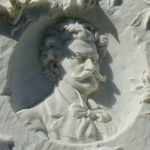
Close your eyes on a balmy night in Vienna’s Zentralfriedhof cemetery and perhaps you can hear a few notes of The Blue Danube drifting on the night air. For here is where you find the grave of one Johann Strauss (the son).
- Buried together with Adele Strauss
- Grave 27, group 32A of the cemetery
- Outside the city center but reachable by tram
- Strauss lies close to a number of famous composers, including other members of the Strauss dynasty, Beethoven, Brahms, and Schubert
- Book a concert experience* for Vienna
- See also:
Death and burial
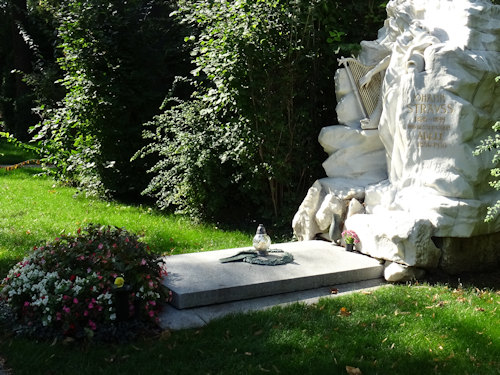
(The grave in the Zentralfriedhof cemetery)
Johann Strauss died of pneumonia at the age of 73 on June 3rd, 1899, in his townhouse in Vienna’s 4th district (Wieden).
That house later fell victim to the bombs of World War II, but a plaque on the replacement building at what is now Johann Strauss Gasse 4 marks the spot. It says (my rough translation):
The King of the Waltz, Johann Strauss (the son) lived and worked in a house at this location from 1878 and died here on June 3rd, 1899
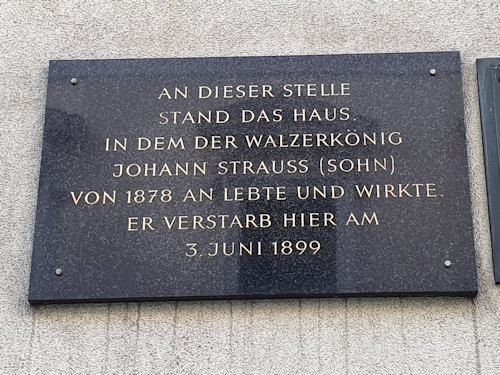
(The plaque marking the location of Strauss’s death)
A funeral ceremony was held on June 6th in the very centre of Vienna at the Evangelical Church (also known as the Lutheran Stadtkirche, still going today and parts of which date back to the late 16th century). Various luminaries attended, including Gustav Mahler.
Strauss was then taken to Vienna’s main cemetery (the Zentralfriedhof) and placed in an open grave, with the formal burial taking place later on June 8th. His last wife, Adele Strauss, died in 1930 and shares the grave with her husband.
Johann Strauss’s first wife, Henriette, and his sisters, Anna and Therese, are buried elsewhere in Vienna (Group 13, grave 73 in Hietzing cemetery, home to both Gustav Klimt and Otto Wagner).
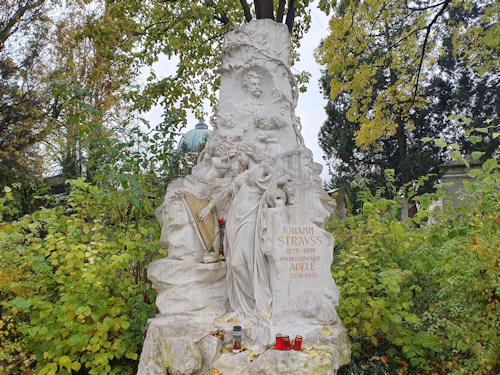
(The headstone)
According to a newspaper report of the time, thousands lined the streets as Johann Strauss’s coffin passed through the city on its journey to the cemetery.
The journalist described the procession as the largest since the funeral of the famous court painter, Hans Makart, who died in 1884.
(Who knows what other musical joys might have sprung from Strauss’s pen if he hadn’t passed away, since he continued working right up until his final illness and death.)
The sculptor, Johannes Benk, designed Strauss’s gravestone. He also designed the Deutschmeister army monument notable for its personification of Vindobona (the name for Roman Vienna).
Other works by Benk include numerous statues and reliefs for many of the famous buildings that went up around the Ringstrassen in the second half of the 19th century.
You can spot the sculptor’s signature just below the simple inscription on the gravestone (my translation):
Johann Strauss 1825-1899 and his wife Adele 1856-1930
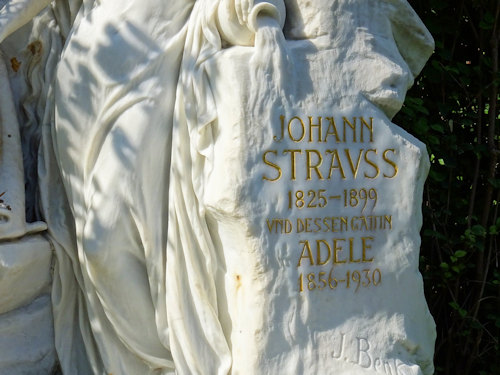
(The gravestone inscription)
How to find Strauss’s grave
Follow the instructions for reaching the Zentralfriedhof, which is freely accessible to the public.
Go straight on once you pass through the main entrance (Tor 2) and head toward the church you can see in the distance.
Keep going until you come across the honorary composer graves on your left (Group 32a on the cemetery maps).
Once you reach the group, a more detailed map displayed at the roadside helps you find the right grave.
Strauss lies in plot 27 on the right-hand side of the group, next to Johannes Brahms and not far from Schubert and Beethoven, for example.
It’s hard to imagine a more resonant location, with the composer graves and memorials kept in beautiful condition and all surrounded by flowers, trees, and shrubs.
Other famous musicians within the Strauss family rest nearby in the same 32a group of graves:
- Johann Strauss (father): grave 15
- Eduard Strauss (brother): grave 42
- Josef Strauss (brother): grave 44
Address: Zentralfriedhof, Simmeringer Hauptstraße 234, 1110 Vienna